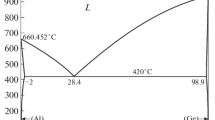Conclusions
The basis for new concepts concerning the eutectic in the liquid and solid states and the interatomic interactions of the eutectic phases has been presented in this article. Improvement of the model requires further experiments and discussions. In discussing any model on the structure of eutectic melt systems one must consider data on the limiting solubility of eutectic components (at temperatures close to the melting temperature of low-melting point components), and find an explanation for the correspondence of the crystallization temperature (during slow cooling) and eutectic melting (if one takes into consideration the inaccuracy of assuming that diffusion plays a determining role in the initial stages of eutectic and contact melting. This inaccuracy was proven in [1, p. 115].).
Similar content being viewed by others
References
V. M. Zalkin, The Nature of Eutectic Alloys and the Effect of Contact Melting [in Russian], Metallurgiya, Moscow (1988).
I. V. Gavrilin, T. B. Frolova, and B. P. Zakharov, "Segregation in liquid eutectic alloys," Izv. Akad. Nauk SSSR, Met., No. 3, 191–193 (1984).
I. V. Gavrilin, B. N. Sharshin, and N. P. Tikhonov, "Chemical and structural inhomogeneities in liquid metallic alloys," Izv. Akad. Nauk SSSR, Met., No. 4, 44–50 (1988).
A. G. Prigunova, Yu. N. Taran, S. S. Petrov, and A. A. Ofengenden, "A method for determining the sizes of microgroups in melts by sedimentation analysis," Rasplavy, No. 5, 3–8 (1991).
V. M. Zalkin, "The nature of eutectics," Zh. Fiz. Khim.,40, No. 10, 2655–2658 (1966).
V. M. Zalkin, "The mechanism of contact meting," Zh. Fiz. Khim.,43, No. 2, 299–304 (1969).
A. A. Vertman and A. M. Samarin, The Properties of Iron Melts [in Russian], Nauka, Moscow (1969).
S. I. Popel' and L. A. Zhukova, "Atom redistribution in germanium-bismuth alloys during melting" Zh. Fiz. Khim.,60, No. 10, 261–262 (1986).
L. A. Zhukova and S. I. Popel', "Atom redistribution in amorphic and liquid alloy films," in: The Structure and Physicochemical Properties of Metallic Melts [in Russian], Ural Sci. Cener, Akad. Nauk SSSR, Sverdlovsk (1986), pp. 81–86.
A. V. Romanova, "The structure and properties of metallic melts" in: Metals, Electrons, and Lattices [in Russian], Naukova Dumka, Kiev (1975), pp. 168–201.
P. S. Popel', "The phase transformation or decomposition of metastable aggregates," Izv. Vyssh. Uchebn. Zaved., Chern. Met., No. 5, 34–37 (1985).
P. S. Popel' and O. A. Korzhavina, "The region of metastable microheterogeneity in melts," Zh. Fiz. Khim.,63, No. 3, 838–841 (1989).
V. I. Danilov, The Structure and Crystallization of Liquids [in Russian], Izd-vo, Akad. Nauk SSSR, Kiev (1956).
B. A. Mel'nik and A. V. Chernovol, "X-ray studies of the crystallization of cast iron," in: The Structure and Properties of Cast Iron, IPL Akad. Nauk USSR, Kiev (1989), pp. 4–8.
A. S. Aronin, V. S. Kraposhin, and K. V. Shakhlevich, "The structure of high-carbon iron alloys after quenching from the liquid state," Metallofizika,12, No. 4, 96–101 (1990).
B. B. Bukhalenko, V. P. Kutuzov, L. A. Rostovskaya, and A. V. Romanova, "The effect of silicon on the structure of iron-carbon alloys," in: The Structure and Properties of Metallic Melts [in Russian], Vol. 2, Ch. 1, Chelyabinsk (1990), pp. 82–84.
A. M. Zakharov, The Constitutional Diagrams of Binary and Ternary Systems [in Russian], Metallurgiya, Moscow (1990).
A. V. Gorokh and N. A. Doroshenko, "The formation of metastable phases during rapid cooling of melts," Izv. Akad. Nauk SSSR, Met., No. 6, 163–168 (1988).
L. K. Savitskaya and L. S. Derevyagina, "Interphase stresses in directional eutectics," in: Structural Formation Mechanisms in Eutectic Alloys [in Russian], Dnepropetrovsk, DMetI (1982), pp. 310–311.
G. P. Grabovetskaya and L. K. Gorenko, "The dislocation structure of interphase surfaces in a directional eutectic," in: Structural Formation Mechanisms in Eutectic Alloys [in Russian], Dnepropetrovsk, DMetI (1982), p. 319.
Ya. I. Dutchak, I. V. Kavich, and I. P. Shevchuk, "The nature of transition metal eutectics," in: The Electron Structure of Refractory Compounds and Alloys [in Russian], Naukova Dumka, Kiev (1980).
K. Sh. Kakhramanov, V. V. Didyk, and R. M. Roshal', "The electron structure of eutectic alloys," Izv. Akad. Nauk SSSR, Neorg. Mater.,19, No. 10, 1613 (1983).
K. Sh. Kakhramanov and R. M. Roshal', "Eutectic compositions-solid-state superstructure," Izv. Akad. Nauk SSSR, Neorg. Mater.,22, No. 10, 1615 (1986).
V. M. Glazov and A. V. Shishkin, "Modeling the structural properties of germanium-tellurium eutectic melts," Zh. Fiz. Khim.,64, No. 4, 915 (1990).
Additional information
Translated from Metallovedenie i Termicheskaya Obrabotka Metallov, No. 11, pp. 2–7, November, 1993.
Rights and permissions
About this article
Cite this article
Zalkin, V.M. The eutectic theory of alloys in the light of new experimental data. Met Sci Heat Treat 35, 607–613 (1993). https://doi.org/10.1007/BF00712281
Issue Date:
DOI: https://doi.org/10.1007/BF00712281




